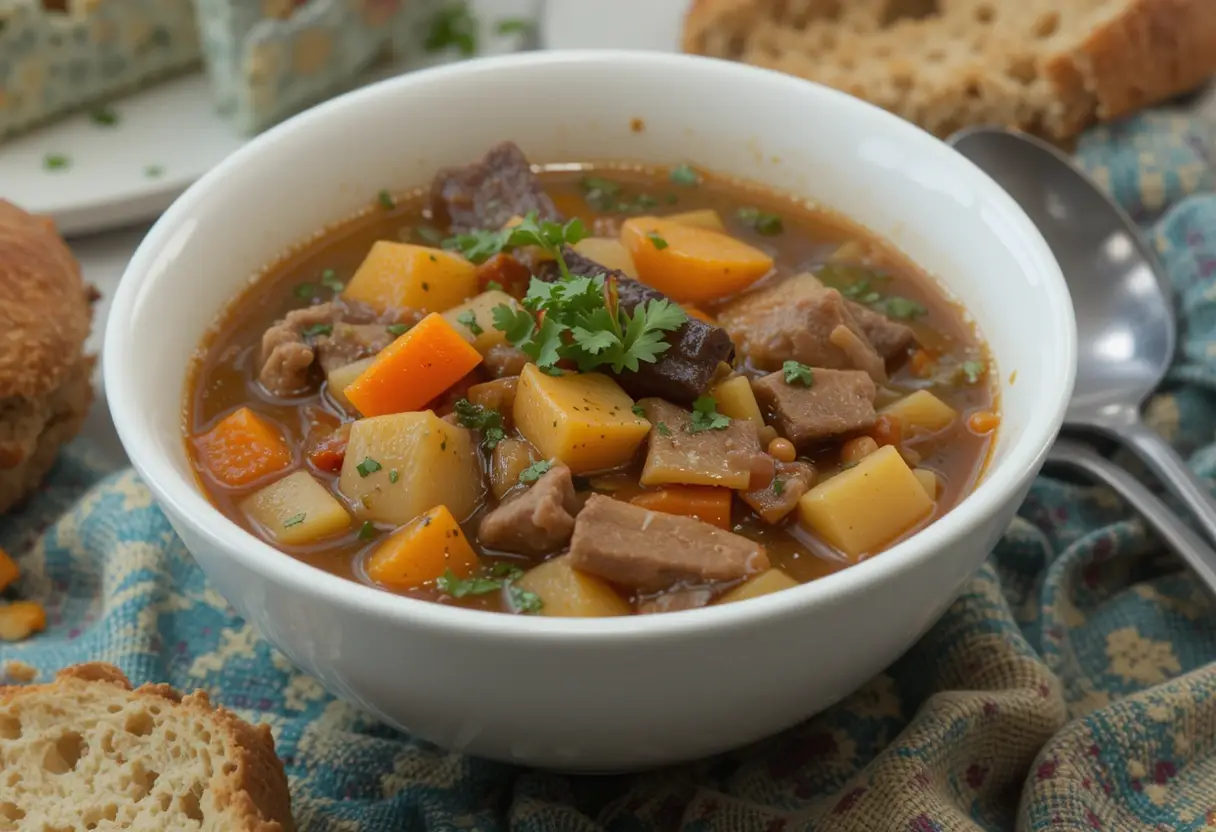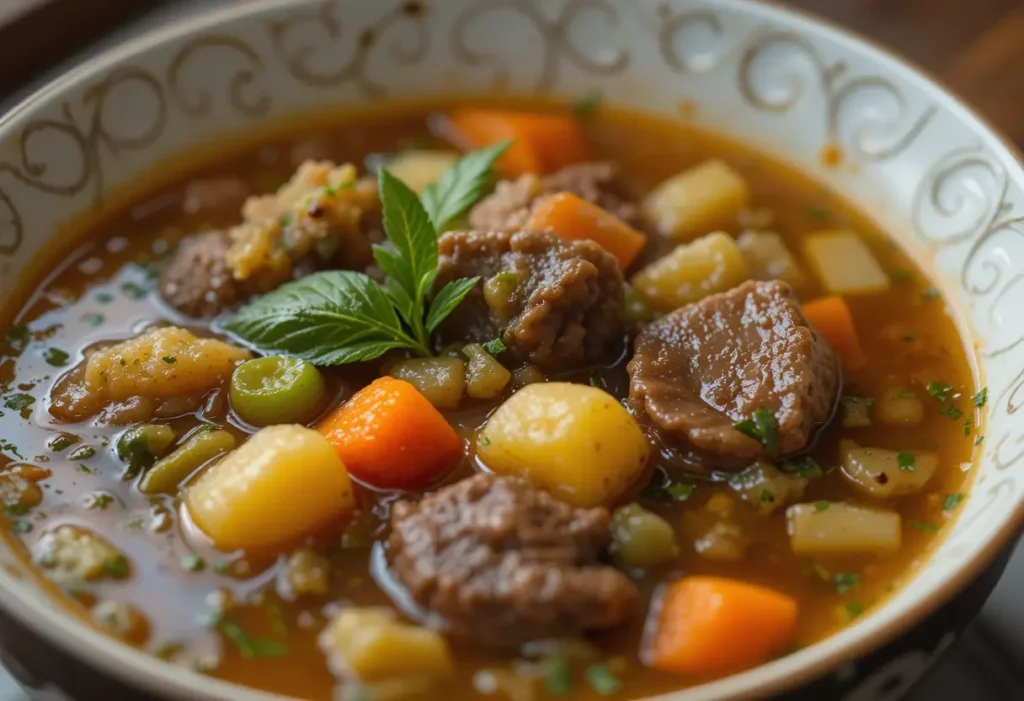There’s something comforting about a bowl of old fashioned vegetable beef soup. It’s a dish that has stood the test of time, gracing dining tables across generations. This hearty and flavorful soup combines tender beef, vibrant vegetables, and a robust broth, creating a meal that warms both body and soul. Whether it’s a cold winter evening or a rainy afternoon, a well made vegetable beef soup feels like a hug in a bowl.
In this guide, we’ll dive into the secrets of crafting the perfect old fashioned vegetable beef soup, exploring its history, benefits, and the steps to create this classic dish from scratch.
Table of Contents
Overview of Traditional Vegetable Beef Soup
The traditional vegetable beef soup is a culinary staple with roots in simplicity and resourcefulness. Historically, it was a way to make use of leftover meat and garden vegetables, creating a dish that was both economical and nutritious. Over time, this humble meal evolved into a beloved comfort food, enjoyed by families worldwide.
The key components of a traditional vegetable beef soup include:
- Beef: Often stewed or slow-cooked to tender perfection, infusing the broth with a rich, savory flavor.
- Vegetables: Common choices are carrots, potatoes, celery, onions, tomatoes, and green beans, though seasonal or personal preferences allow for creativity.
- Broth: A robust base, typically beef stock or broth, seasoned with herbs and spices to enhance the flavor profile.
The beauty of this dish lies in its versatility. It welcomes adjustments and improvisation, making it suitable for a variety of tastes and dietary needs.
Benefits of Homemade Soup
Making vegetable beef soup from scratch isn’t just about flavor—it’s also a rewarding process that brings numerous benefits:
- Nutritional Value: Homemade soup is packed with fresh vegetables and quality ingredients, offering a wholesome meal rich in vitamins, minerals, and protein.
- Customizable: Preparing soup at home allows you to control salt levels, omit unwanted additives, and tailor the recipe to dietary restrictions.
- Cost-Effective: Utilizing affordable ingredients and leftovers, homemade soup is a budget friendly way to feed a family.
- Comfort and Connection: Cooking and sharing a homemade meal fosters connection and creates cherished memories with loved ones.
- Health Benefits: Warm soups are soothing for the throat, aid digestion, and can even provide relief during colds or flu.
By mastering the art of old fashioned vegetable beef soup, you’re not just creating a dish—you’re preserving a tradition, enriching your diet, and cultivating a sense of comfort and nostalgia.
Stay tuned as we unveil the secrets, step by step instructions, and tips to elevate your soup making game to the next level.
Key Ingredients for Old Fashioned Vegetable Beef Soup
Best Cuts of Beef for Soup
- Chuck Roast: 1–1.5 pounds, trimmed and cut into 1-inch cubes.
- Stew Meat: 1–1.5 pounds, pre-cut for convenience.
- Shank or Brisket: 1.5 pounds, sliced or cubed for rich flavor.
- Oxtail (optional): 1 pound, for additional depth and a gelatinous broth.
Essential Vegetables and Their Nutritional Value
- Carrots: 3 medium sized, peeled and chopped (provides beta carotene, fiber, and antioxidants).
- Potatoes: 3 large, peeled and diced (offers carbohydrates and potassium).
- Celery: 2–3 stalks, sliced (rich in vitamins A, K, and C).
- Onions: 1 large, diced (source of antioxidants and adds depth to flavor).
- Tomatoes: 2 cups diced fresh or 1 can (14–16 oz) of crushed tomatoes (high in vitamin C and lycopene).
- Green Beans: 1 cup, trimmed and cut into bite sized pieces (provides vitamins A, C, and K).
- Corn (optional): 1 cup fresh or frozen (adds sweetness and contains folate).
- Peas (optional): 1 cup fresh or frozen (rich in fiber and vitamin K).
Herbs and Spices That Enhance Flavor
- Parsley (fresh): 2 tablespoons chopped, plus extra for garnish (adds brightness).
- Thyme (dried): 1 teaspoon (earthy and aromatic).
- Bay Leaves: 2 whole (deepens flavor; remove before serving).
- Garlic: 3 cloves, minced (enhances savory notes).
- Paprika (optional): 1 teaspoon smoked or sweet (adds warmth and color).
- Black Pepper: 1/2 teaspoon freshly ground (classic seasoning).
- Salt: To taste, approximately 1 teaspoon for initial seasoning (adjust during cooking).
- Red Pepper Flakes (optional): 1/4 teaspoon for mild heat.
Liquid Base
- Beef Broth or Stock: 6–8 cups (provides a robust base).
- Water (optional): 2–3 cups for a lighter consistency.
Cooking Oil
- Olive Oil or Vegetable Oil: 2 tablespoons (for searing beef and sautéing vegetables).
These quantities are ideal for making 6–8 hearty servings of old fashioned vegetable beef soup. Adjust proportions based on your preferences or serving size needs.
Step-by-Step Cooking Guide
Preparing Your Ingredients
- Beef:
- Select 1–1.5 pounds of your chosen beef cut (e.g., chuck roast, stew meat, or shank).
- Trim excess fat and cut the meat into 1-inch cubes for even cooking.
- Season the beef generously with salt and pepper to enhance flavor.
- Vegetables:
- Wash all vegetables thoroughly.
- Peel and chop 3 medium carrots and 3 large potatoes into evenly sized pieces.
- Slice 2–3 celery stalks into thin, uniform pieces.
- Dice 1 large onion and trim 1 cup of green beans into bite sized pieces.
- If using, prepare 1 cup each of corn and peas.
- Herbs and Spices:
- Measure your dry herbs (e.g., 1 teaspoon thyme, 2 bay leaves).
- Mince 3 cloves of garlic and chop fresh parsley (about 2 tablespoons).
- Broth and Oil:
- Have 6–8 cups of beef broth or stock ready.
- Use 2 tablespoons of olive oil or vegetable oil for cooking.
Cooking Techniques for Maximum Flavor
- Searing the Beef:
- Heat 2 tablespoons of oil in a large soup pot or Dutch oven over medium high heat.
- Add beef cubes in a single layer and sear on all sides until browned. Work in batches to avoid overcrowding.
- Remove the seared beef and set aside.
- Sautéing Aromatics:
- In the same pot, add diced onions, celery, and garlic.
- Cook for 3–5 minutes until soft and fragrant, scraping up any browned bits from the bottom.
- Deglazing the Pot:
- Pour in 1/2 cup of broth or a splash of wine to deglaze.
- Stir and scrape the bottom to incorporate the flavorful browned bits into the base.
- Layering Flavors:
- Return the seared beef to the pot and add the remaining broth.
- Stir in tomatoes, carrots, and potatoes for the initial simmer.
- Add thyme, bay leaves, paprika, and black pepper for seasoning.
- Simmering the Soup:
- Bring the soup to a boil, then reduce heat to low and let it simmer gently.
- Cover partially and cook for 1.5–2 hours, stirring occasionally.
- Adding Delicate Vegetables:
- In the last 20–30 minutes of cooking, add green beans, corn, and peas.
- Taste and adjust seasonings as needed (add salt or pepper).
Tips for Cooking Beef to Tender Perfection
- Searing for Flavor:
- Always sear the beef before simmering to lock in juices and enhance the overall flavor.
- Simmer Gently:
- Avoid boiling the soup aggressively, as it can toughen the meat. Keep the heat low and allow time for the collagen to break down.
- Check for Doneness:
- Use a fork to test the beef. When tender and easy to pull apart, it’s ready.
- Use the Right Pot:
- A heavy bottomed pot or Dutch oven distributes heat evenly and retains moisture, perfect for slow cooking.
- Shredding for Texture (Optional):
- If using larger cuts, shred the beef with a fork after cooking for a rustic presentation.
It’s a hearty, comforting dish that will delight everyone at the table.
Storing and Reheating Tips
Best Practices for Soup Storage
- Cooling the Soup:
- Allow the soup to cool to room temperature before storing. This prevents condensation and helps maintain the soup’s texture and flavor.
- Using the Right Containers:
- Store soup in airtight containers to preserve freshness and prevent contamination.
- Use portion sized containers for easy reheating.
- Refrigeration:
- Store soup in the refrigerator for up to 3–4 days. Ensure the temperature remains below 40°F (4°C).
- Freezing:
- For longer storage, freeze soup in freezer safe containers or resealable bags. Leave some space at the top for expansion.
- Label containers with the date to track freshness. Frozen soup can last 3–6 months.
- Avoid Freezing Certain Ingredients:
- If possible, freeze the base soup and add delicate ingredients like green beans or potatoes fresh during reheating to maintain texture.
How to Reheat Without Losing Flavor
- Thawing Frozen Soup:
- Move frozen soup to the refrigerator overnight to thaw gradually. Alternatively, use a microwave’s defrost setting.
- Stovetop Reheating:
- Pour soup into a pot and heat over medium low, stirring occasionally to prevent sticking or uneven heating.
- Add a splash of water or broth if the soup thickened during storage.
- Microwave Reheating:
- Transfer soup to a microwave safe container, loosely cover, and heat in 1–2 minute intervals. Stir between intervals for even reheating.
- Re-seasoning:
- Taste the reheated soup and adjust the seasoning as needed, especially if frozen, as flavors may mellow over time.
Nutritional Information
Caloric Content Per Serving
- Estimated Calories:
- A typical serving (about 1.5 cups) of beef soup contains around 200–250 calories, depending on the ingredients and portion sizes.
- Macronutrient Breakdown:
- Protein: 15–20 grams (from beef).
- Carbohydrates: 15–20 grams (from vegetables like potatoes, carrots, and corn).
- Fat: 6–10 grams (from beef and cooking oil).
- Fiber: 3–5 grams (from vegetables).
Health Benefits of a Balanced Soup
- Rich in Nutrients:
- Packed with essential vitamins (A, C, K) and minerals (potassium, iron) from fresh vegetables.
- High in Protein:
- The beef provides a good source of protein, supporting muscle repair and overall energy.
- Low in Calories:
- A nutritious, filling meal that’s naturally low in calories, making it ideal for weight management.
- Boosts Immunity:
- Ingredients like garlic, onions, and tomatoes are rich in antioxidants and immune boosting properties.
- Heart Health:
- Homemade soup allows for control over sodium content, reducing the risk of hypertension.
- Digestive Health:
- Fiber-rich vegetables support gut health and digestion.
This soup isn’t just a comforting meal—it’s a powerhouse of nutrients that supports overall health while delighting your taste buds.
Common Mistakes to Avoid in Soup Preparation
Overcooking Vegetables
- Mushy Vegetables:
- Adding all vegetables at once can lead to overcooking. Hardier vegetables like carrots and potatoes need longer cooking, while delicate ones like peas or green beans should be added later.
- Timing is Key:
- Cook vegetables until just tender to retain their texture and nutrients. Overcooking diminishes flavor and makes the soup less appealing.
Managing Salt and Seasoning
- Too Much Salt:
- Start with less salt and adjust toward the end. Soup flavors concentrate as they simmer, which can make the soup overly salty if added early.
- Flat Flavor:
- Taste regularly and layer seasonings (e.g., herbs, garlic, or spices) throughout the cooking process for depth. Avoid relying solely on salt for flavor.
- Fixing Mistakes:
- If soup becomes too salty, balance it by adding more broth, a potato to absorb salt, or a splash of acid like lemon juice or vinegar.
Frequently Asked Questions (FAQ)
What are the best beef cuts for a budget friendly version?
- Stew Meat: Affordable and pre-cut for convenience.
- Chuck Roast: Economical and tender when slow cooked.
- Oxtail or Shank: Flavorful and budget friendly, though they may require additional prep.
Tips for enhancing soup flavor without salt?
- Use aromatic vegetables like onions, garlic, and celery to build a strong flavor base.
- Add herbs and spices like thyme, bay leaves, paprika, or black pepper.
- Incorporate a splash of acid (e.g., lemon juice or vinegar) for brightness.
- Use rich beef broth or stock instead of water for depth.
Best season to enjoy old fashioned vegetable beef soup?
This soup is versatile and can be enjoyed year round:
- Winter and Fall: Perfect for cold weather, offering warmth and comfort.
- Spring and Summer: Lighten it up by using seasonal vegetables and serving with crusty bread.
How to thicken the soup without using flour?
- Puree Vegetables: Blend a portion of the soup and stir it back in for natural thickness.
- Use Starches: Add mashed potatoes or cooked rice for a hearty texture.
- Cornstarch or Arrowroot Slurry: Mix with water and stir into the simmering soup for instant thickening.
- Legumes: Puree cooked beans or lentils for a creamy consistency.
By avoiding common mistakes and utilizing these tips, you can create a flavorful and perfectly balanced beef soup that suits any dietary need or season.
Conclusion
Old-fashioned vegetable beef soup is more than just a dish; it’s a tradition that brings warmth and nourishment to the table. For more hearty recipes, check out our guide to Chili Soup Delights: A Bowl of Comfort and Flavor or explore the lighter side with our Vegetarian Lasagna Soup. Whether you’re seeking comfort or variety, these recipes are sure to inspire your next meal.
Enjoy your cooking journey!


